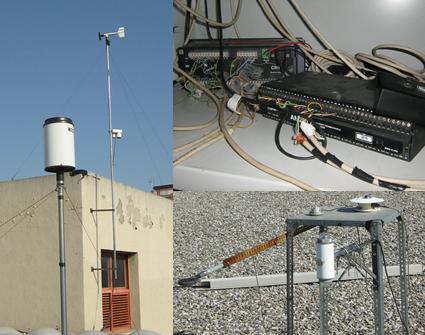Continuous Measurements
Unlike most laboratories housed in buildings protected from the environment, the Atmospheric Physics Laboratory is exposed to the elements on the rooftop of the Physics building of the Science Faculty of the University of Granada. In essence, this is a meteorological station that makes continuous measurements of the state of the atmosphere, registering the variables indicated in the following table:
| Measured variables | Instrument model and make |
|---|---|
| Air temperature (T) and relative humidity (RH) | Thermohygrometer HMP45C, Vaisala |
| Net Radiation (Rn) | NR-Lite Net Radiometer, Kipp & Zonen |
| Global Radiation (Rg) | SP-Lite Silicon Pyranometer, Kipp & Zonen |
| Incident and Reflected visible radiation (Rup, Rdown) | Albedometer CM 5, Kipp & Zonen |
| Windspeed (U) and direction (Wdir) | Wind monitor model 05103, RMYoung |
| Atmospheric Pressure (Press) | Barometro RPT410F, Druck |
| Precipitation (Precip) | Pluviometer Model 52203 RMYoung |
| Infrarred Radiation (Radterm, Tinterat) | Eppley Precision Infrared Radiometer (Pyrgeometer), EPPLEY LABORATORY |
Each of these sensors is connected to a datalogger (CR10, Campbell Scientific), which stores means (e.g., temperature) or totals (e.g., precipitation) every half hour. Although the autonomy of the system is about 489 days (16 months), the CR10 is also connected to an NL100/105 network link interface, to enable data downloading by internet. The University of Granada’s 19th program of support for teaching laboratories (2011 call for proposals) provided funds for the procurement of an RTMC-WS web server and the LOGGERNET software necessary to enable real-time access to these data on a webpage (these elements have been ordered and will be installed once they arrive).

Aerological Soundings
In addition to the continuous measurements mentioned above, the laboratory is equipped with the materials to launch periodic aerological soundings. Each sounding requires a balloon and a paquet of sensors for measuring vertical profiles (of the troposphere, up to approximately 10km where the balloon tends to burst). The data provided include the hour of day of the measurement, air temperatura and relative humidity, windspeed and direction, geopotential height, dew point temperatura, and the equivalent temperature.